ALT. FUEL
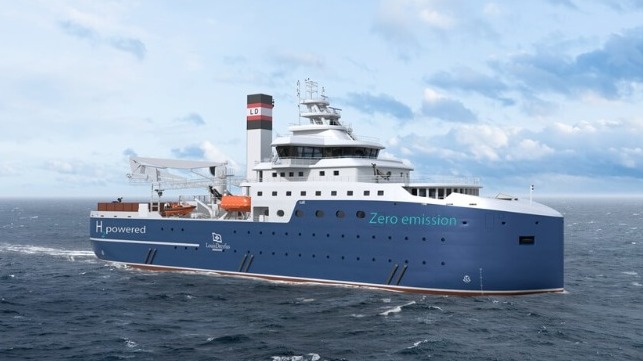
Published Apr 10, 2025 7:46 PM by The Maritime Executive
The French shipping company Louis Dreyfus Armateurs (LDA) has received an Approval in Principle for its new liquid hydrogen-based SOV design. The Level 1 AiP was given by Bureau Veritas Marine& Offshore. This brings the groundbreaking Service Operation Vessel (SOV) design closer to reality.
The 100% hydrogen-powered SOV will be able to operate 95 percent of the time with zero carbon emissions during standard operations. This will lead in a reduction of an estimated 4,000 tonnes of annual CO2 emissions. The vessel will have capacity to accommodate up to 90 technicians for up to 14 days at sea, eliminating the need for additional offshore infrastructure. Refueling has been streamlined, as bunkering can be completed in six hours using trailers, eliminating the need for high-cost port facilities.
LDA introduced the hydrogen SOV concept design back in March 2024, in cooperation with Norwegian naval architecture company Salt Ship.
“We believe in developing purpose-built SOVs tailored to specific projects and needs. We are already offering alternative fuel options such as full electric and dual-fuel methanol. We firmly believe that hydrogen will be one of the options in the near future. This AiP represents a key step in making hydrogen-powered maritime operations a reality,” said LDA.
Other projects working to develop liquid hydrogen-powered vessels include the H2ESTIA Project, led by the Dutch innovation company NIM and supported by the Dutch government. The project launched last month, and aims to design, construct and demonstrate a hydrogen-powered bulk vessel to operate in the North Sea and beyond. The short-sea and inland shipping company Van Dam Shipping will manage the vessel.
However, in its bi-annual 2025 Hydrogen Market Outlook report this week, BloombergNEF indicated that the hydrogen sector has been in decline. “Costs have remained high and demand stayed low as a result. Policy has failed to bridge the gap between prices suppliers need to build viable projects and the prices buyers need to get justifiable business case. As a result, investments in the sector fell in 2024, with developers canceling projects,” said Martin Tengler, Head of Hydrogen Research, BloombergNEF.
But Tengler believes a rebound could be expected in places such as Europe, China, Japan and South Korea, where there are incentives offering developers opportunities for investment.
Fincantieri and Viking Unveil World's First H2-Powered Cruise Ship
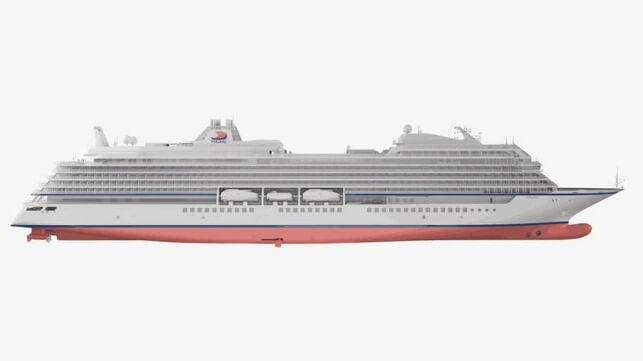
Published Apr 8, 2025 12:24 PM by The Maritime Executive
Fincantieri and Viking have announced the world's first hydrogen-powered cruise ship designed to use the alternative fuel for both propulsion and auxiliary power. The future Viking Libra is already under construction at the Ancona yard in Italy, and will deliver towards the end of 2026.
Viking Libra is a small 54,000 GT vessel with room for about 1,000 guests. With H2 fuel cell power, it will be able to operate with zero carbon emissions, which will soon be a regulatory requirement for operations in Norway's World Heritage fjords (a major attraction in Viking's core Scandinavian market).
It will be fitted with fuel cells producing up to six megawatts of power, equivalent to roughly 8,000 horsepower of generator capacity. The PEM fuel cell technology and related equipment are supplied by the Fincantieri subsidiary Isotta Fraschini; to solve the supply chain problems of hydrogen bunkering, it uses a containerized fuel storage system to load and store the fuel.
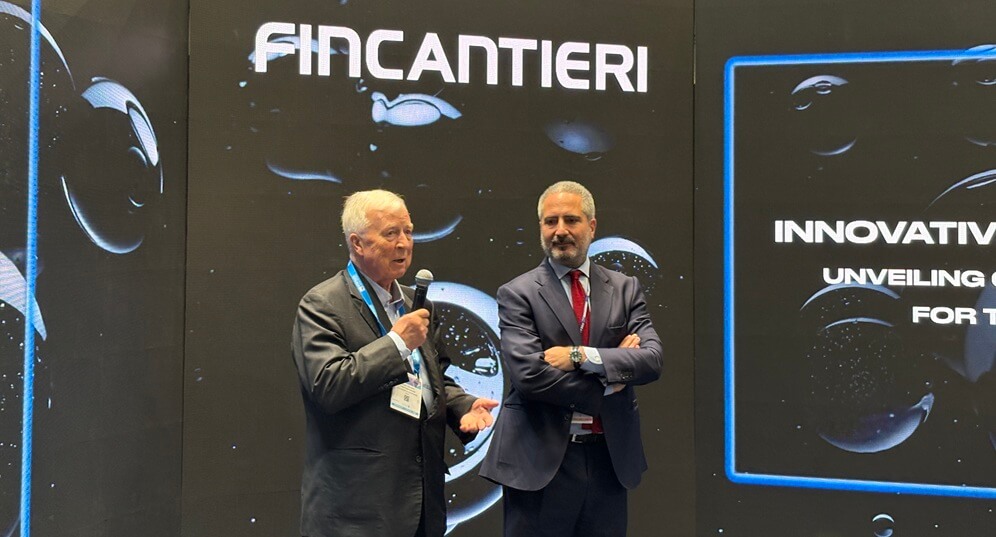
Viking chief Torsten Hagen (left) unveils Viking Libra at Seatrade Cruise Global 2025 (Allan Jordan / TME)
“LNG is not a way to the future, but . . . this new solution is a good bet for the future," said Viking chairman and CEO Torsten Hagen in a presentation at Seatrade Cruise Global.
Viking said that price is an issue for H2-powered operation, but they believe that the price will come down in the future, and they want to illustrate a path forward for the industry. The containerized approach addresses the challenges of storage and distribution, and makes it possible to add incremental power capacity with more 1.5 MW units.
"Viking made the principled decision to invest in hydrogen, which offers a true zero-emission solution," said Hagen. "We look forward to welcoming the world's first hydrogen-powered cruise ship to our fleet."
A follow-on vessel, Viking Astrea, will also be fitted for hydrogen power and is already under construction at Ancona. In a parallel announcement, Fincantieri said that it has signed a 2+2 contract with Viking for additional vessels, starting with a firm orders for two hulls to deliver in 2031.
"We are driving a systemic evolution by integrating cutting-edge technologies, fostering supply chain innovation, and creating a model for the widespread adoption of hydrogen," said Fincantieri CEO Pierroberto Folgiero in a statement.
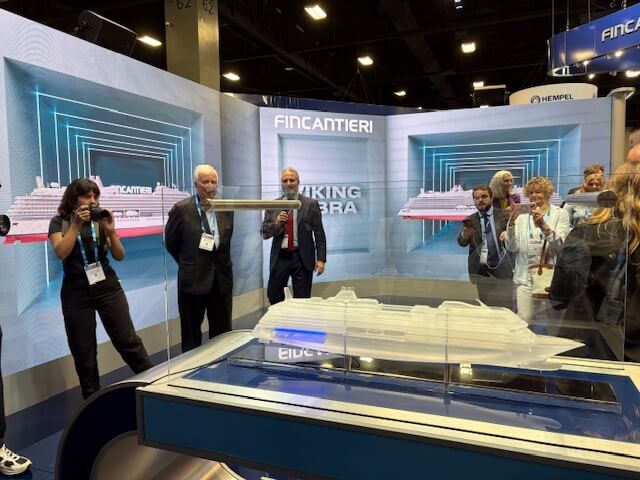
Allan Jordan / TME
Grimaldi Orders Nine Methanol-Ready Ropaxes for Med and Baltic Routes
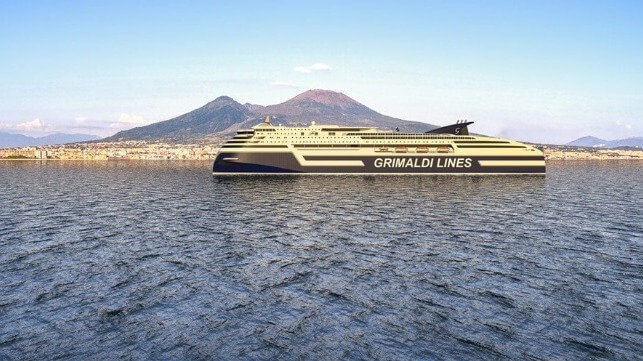
Published Apr 9, 2025 10:07 PM by The Maritime Executive
Italy’s short-sea transportation company Grimaldi Group is accelerating investments in a younger and more efficient fleet of eco-friendly ro-pax carriers, committing $1.3 billion for nine newbuilds at China Merchants Jinling Shipyard (Weihai).
The company says that the nine pioneering vessels, which are part of its fleet expansion and renewal program, will be equipped with engines capable of running on methanol and will be designed to move rolling cargo and passengers in the Mediterranean and the Baltic Sea.
The newbuilds will be delivered between 2028 and 2030, and will be used by the group’s three brands - Grimaldi Lines, Minoan Lines and Finnlines. Four will be operated under the Grimaldi Lines brand sailing under the Italian flag, while two will be for Minoan Lines, under the Greek flag. These six, belonging to the “Next Generation Med” class, will serve routes in the Mediterranean. The other three, which debuts as the “Hansa Superstar” class, will be delivered to Finnlines to serve routes in the Baltic Sea.
At a length of 229 meters, the Mediterranean ro-pax vessels will have a cargo capacity of 3,300 lane meters for rolling freight and over 300 cars and up to 2,500 passengers. The Baltic Sea newbuilds will be 240 meters long with a cargo capacity of 5,100 lane meters for rolling freight plus 90 cars and up to 1,100 passengers.
Grimaldi has a long relationship with China Merchants, and the new orders extend that partnership with the introduction of fuel-efficient technology. The new vessels will have optimized hull and propeller designs, energy-efficient onboard power management systems, shore power readiness and the application of silicon-based hull coatings. They will reduce CO? emissions per transported cargo unit by more than 50 percent compared to vessels currently operating on the same routes, Grimaldi says.
“The new Next Generation Med and Hansa Superstar classes are the result of a thorough study of our customers’ needs and, more broadly, those of shipping. Today more than ever, the latter requires quality, efficiency and environmental sustainability to remain a key mode of national and international freight and passenger transport,” said Emanuele Grimaldi, Grimaldi Group Managing Director.
He added that the performance in CO? emission reduction and the use of methanol are critical components in the company’s net zero goals. Grimaldi is working to achieve zero emissions by 2050.
The new order comes just weeks after the company took delivery of the last of 14 hybrid ro-ro ships of its "fifth generation" class, built at China Merchants Jinling shipyard in Nanjing. This year and next year, the company also expects to start taking delivery of five new pure car and truck carriers from China Merchants.
MAN 175D Engines Selected for Carbon Capture Storage Application
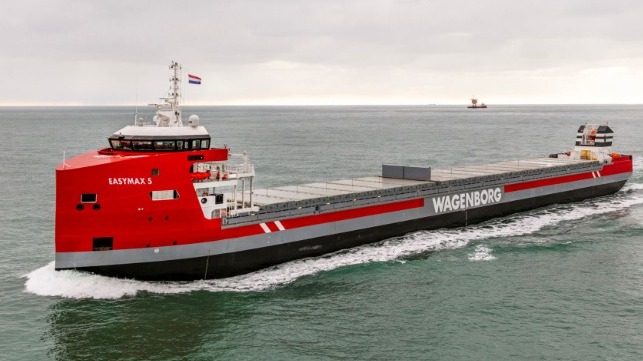
Published Apr 10, 2025 12:21 PM by The Maritime Executive
[By: MAN Energy Solutions]
The Royal Niestern Sander shipyard in the Netherlands has ordered 2 × MAN 16V175D MEM engines (2,400 kWm/1,800 rpm) in connection with the building of an MPV (Multi-Purpose Vessel) vessel – ‘Easymax 5’ – for Dutch outfit, Wagenborg Operator. The engines will be employed as GenSets for power generation aboard the purpose-built CO2 carrier, which will be employed in the offshore, substrate storage of CO2.
The vessel will be the fifth under the EasyMax concept jointly developed by Wagenborg and Niestern Sander with a cargo capacity of 14,000 tons. It will ultimately be chartered by Ineos, Denmark and the 175D engines are scheduled for delivery during 2025.
The CO2 for storage will come from a bio-gas plant in Denmark, from where it will be transported to Esbjerg on the Danish west coast for loading aboard the vessel before proceeding to the Greensand storage site in the Danish North Sea. The MAN 175D GenSets are intended to give the Easymax 5’s CO2 pump and DP2 systems more power during discharge into offshore storage.
Bart Speckens, Regional Sales Manager, MAN Energy Solutions, said: “This order represents a new type of reference for the 175D. In general, 175D is a versatile engine with the lowest environmental footprint and operating costs in its class due to its high fuel-efficiency and long service-intervals. We’re proud to be involved in such a crucial project that ultimately will sequester millions of tonnes of carbon dioxide from hard-to-abate industries.”
In keeping with its slogan of ‘Moving Big Things to Zero’, MAN Energy Solutions provides the shipping industry with green engines that can operate on climate-neutral fuels, but also offers the actual carbon-capture-and-processing technologies essential for global industry to achieve net zero. Once captured, CO2 can be stored and reused to form the backbone of a circular carbon economy. Of the 18 large-scale facilities currently in commercial operation globally, fully eight employ MAN CO2 compression technology.
About the MAN 175D engine
MAN Energy Solutions developed the MAN 175D engine range to supplement and complete its product portfolio in the maritime sector. Available in three variants of 12-, 16- and 20-cylinders, the engine is available with an output ranging from 1,500 to 4,400 Kilowatts and is optimised for propelling ferries, offshore support ships, tugs and other working vessels. Other market areas, such as superyachts, planing yachts and naval marine applications are also served by additional engine variants.
The 175D is also an extremely eco-friendly engine, having been designed from the outset for low fuel consumption, coupled with compliance to the latest exhaust-gas-emission standards and considering as well future-fuel requirements where it is already cleared for operation on biofuels such as FAME and HVO.
The products and services herein described in this press release are not endorsed by The Maritime Executive.
No comments:
Post a Comment